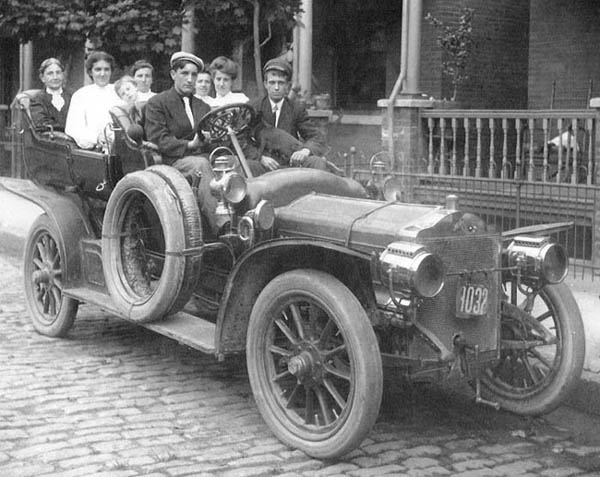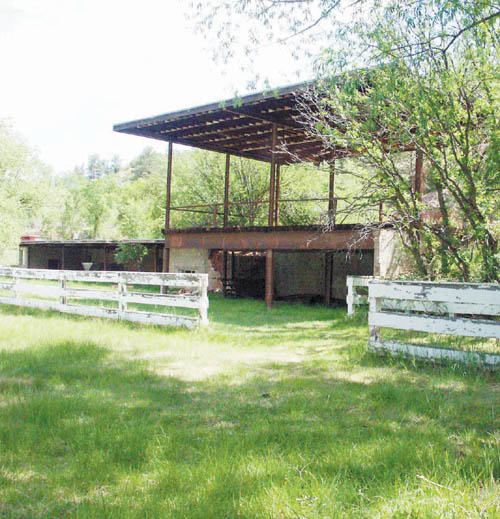 Dave Hughes poses with an 1840s-era muzzle-loading firearm that he bought from the sons of John G. Bock. It had been part of the collection in the western museum that the elder Bock owned in Old Colorado City in the 1930s. Westside Pioneer photo
|
But to whom should Colorado Springs be thankful for preserving the natural beauty of this recreational area from the earliest days that pioneers camped there? All that most people know is that the City of Colorado Springs, with $12.5 million in Trails, Open Space and Parks (TOPS) sales-tax money, purchased the entire “Red Rock Canyon” a decade ago.
Few know that the property is a 90-year legacy from the Bock family. It was John G. Bock, the cowboy from Pennsylvania and World War I wounded veteran, who gradually assembled the 789 acres of spectacular red rocks and wildlife refuge starting in 1923. It was he who reclaimed the natural area from the industrial debris left by 1890s industrial quarrying operations.
 John G. Bock, then about age 21, is shown behind the wheel of a car with family members in 1910, long before he moved to Colorado. Courtesy of George Bock and Dave Hughes
|
And it was his sons, born on that land, who tended, groomed and watered, at their expense, the natural land for 40 years after he passed on, while pursuing their own dreams of what the spectacular site could be turned into. That was the first Bock family legacy.
Westsiders especially should know the essence of the Bock family story. I know it, not only from my studying its history, but by helping son John in the early 1980s as he and his architect brother Richard tried, against the resistance of many local government obstructionists, to pursue their own dreams on the land their father had slowly assembled, acre by acre. They admired what I had accomplished in getting Old Colorado City revitalized in the late 1970s. In turn I was one of the few locals who could get along with them and critique their plans. For the self-made Bocks' were rugged, independent-minded, often cantankerous, Westsiders.
John G. Bock had originally passed through Colorado Springs by train in 1907, glimpsing the beautiful region, before he pressed on to Higbee in southern Colorado to become a cowboy rancher. He eventually acquired the entire JJ open-range ranch there.
Reluctantly drafted in WWI, he was bombed, gassed and wounded - for which he was awarded a Purple Heart years later.
When he returned to Colorado in 1919, he married Sylvia Seay. They first went back to his JJ ranch. But by 1923, his wounds were such he decided to try the less stressful real estate business in Colorado Springs, moving into a house in the 3200 block of West Colorado Avenue at “Adams Crossing” and making the acquisition and development of Red Rock Canyon his lifelong project.
He first built his “Roundup Stables” on Colorado Avenue from which tourists could ride horses for $1 across his growing, picturesque private property. The couple built and rented tourist cottages and leased other land. While John was recuperating from tuberculosis, Sylvia managed things and gave birth to their two sons - John S. and Richard.
 John G. Bock ran his Roundup Stables on Colorado Avenue as a business offering horseback rides to tourists through Red Rock Canyon, but the family also had this stabling facility on the property itself, not far from the house later built by Bock's son, John S. Bock (now the site of the pavilion). The Red Rock stable was demolished about eight years ago as part of a City Parks policy of eliminating the Bock-built structures from the property (including their houses). A sign near the pavilion tells some of the Bock story. Westside Pioneer file photo
|
Soon enough the boys helped out with the family enterprises and went to college. John S. became a petroleum engineer, working in Venezuela for a time, and Richard became an architect, which skill he later applied to his family's dream for Red Rock Canyon.
In 1975 I came on the Westside scene.
Dave Hughes can be contacted at dave@oldcolo.com.